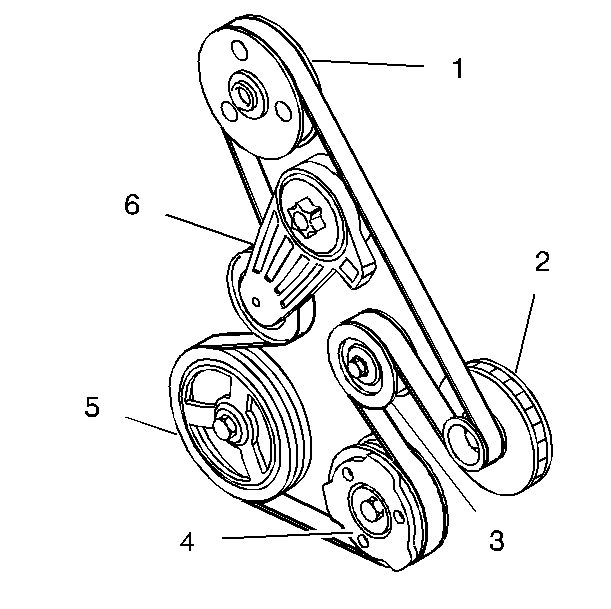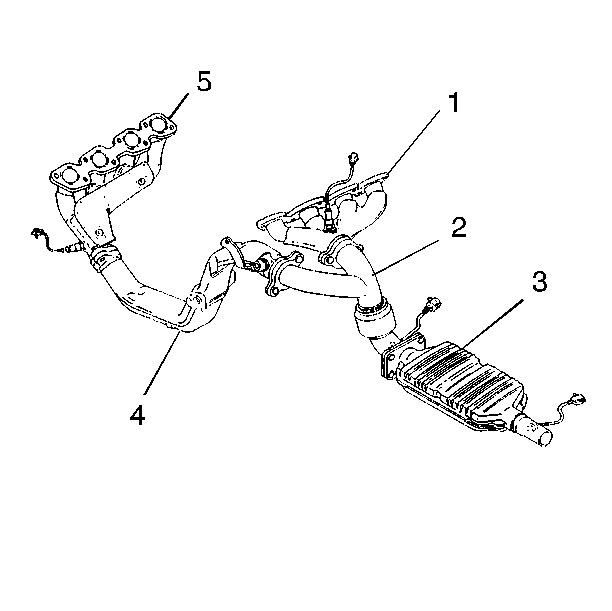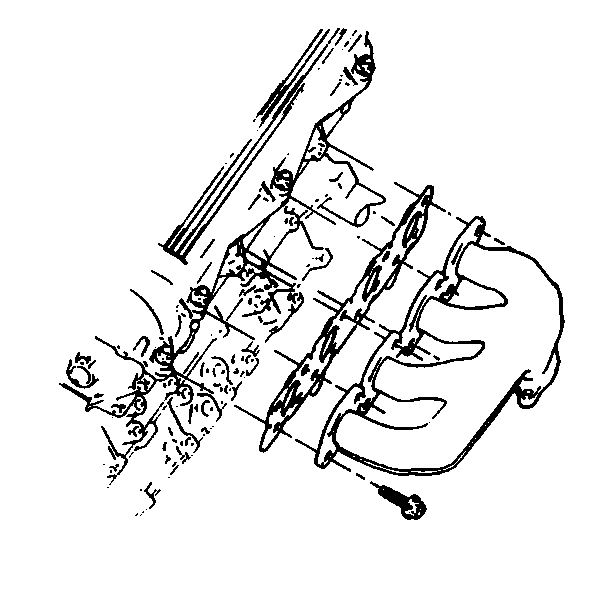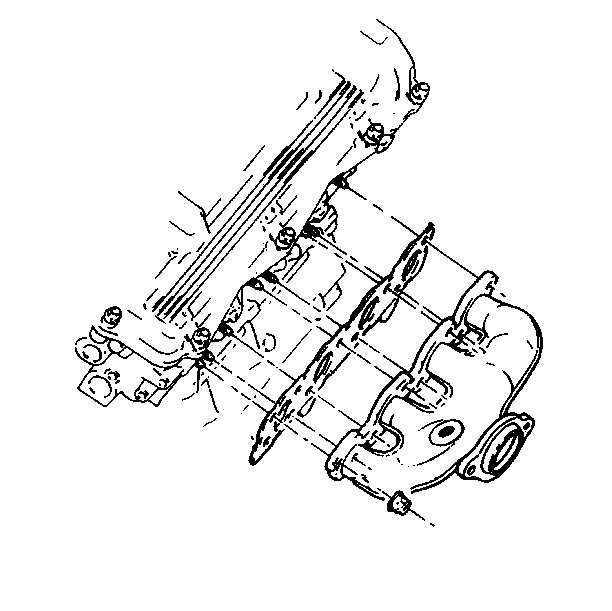Exhaust Manifold Replacement Left
Removal Procedure
- Disconnect the negative battery cable.
- Remove the accessory drive belt from the power steering (1) and generator pulleys (2). Set the belt aside.
- Remove the upper retaining bolt from the generator. Refer to Generator Replacement in Engine Electrical.
- Raise the vehicle. Refer to Lifting and Jacking the Vehicle
- Remove the splash shield from the right wheel well.
- Remove the lower center air deflector.
- Remove the generator. Refer to Generator Replacement in Engine Cranking.
- Set the generator aside.
- Remove the left exhaust manifold (5) to exhaust crossover pipe (4) bolts.
- Remove the electrical connector at the oxygen sensor.
- Remove the power steering line retainers.
- Remove the left exhaust manifold nuts.
- Remove the left exhaust manifold.
- Remove the left exhaust manifold gasket. Discard the gasket.
- Remove the oxygen sensor from the manifold. Refer to Heated Oxygen Sensor Replacement in Engine Controls.
Caution: Unless directed otherwise, the ignition and start switch must be in the OFF or LOCK position, and all electrical loads must be OFF before servicing any electrical component. Disconnect the negative battery cable to prevent an electrical spark should a tool or equipment come in contact with an exposed electrical terminal. Failure to follow these precautions may result in personal injury and/or damage to the vehicle or its components.



Installation Procedure
- Coat the threads of the oxygen sensor with high temperature anti-seize, P/N 5613695, or equivalent.
- Install the oxygen sensor. Refer to Heated Oxygen Sensor Replacement in Engine Controls.
- Install the gasket to the cylinder head.
- Install the exhaust manifold by inserting the outlet pipe partially into the exhaust crossover pipe. Move the exhaust manifold into position.
- Install the exhaust manifold nuts.
- Install the electrical connector to the oxygen sensor.
- Install the power steering line retainers.
- Install the lower retaining bolt to the generator.
- Install the generator rear bracket bolt and nut.
- Install the bolts at the manifold outlet flange. New fasteners are recommended for maximum joint integrity.
- Install the lower center air deflector.
- Install the splash shield to the right wheel well.
- Lower the vehicle.
- Install the upper retaining bolt to the generator.
- Install the drive belt onto the power steering and generator pulleys.
Notice: Use the correct fastener in the correct location. Replacement fasteners must be the correct part number for that application. Fasteners requiring replacement or fasteners requiring the use of thread locking compound or sealant are identified in the service procedure. Do not use paints, lubricants, or corrosion inhibitors on fasteners or fastener joint surfaces unless specified. These coatings affect fastener torque and joint clamping force and may damage the fastener. Use the correct tightening sequence and specifications when installing fasteners in order to avoid damage to parts and systems.
Tighten
Tighten the oxygen sensor to 40 N·m (30 lb ft).

Tighten
Tighten the nuts to 25 N·m (18 lb ft).
Tighten
Tighten the retaining bolt to 50 N·m (37 lb ft).
Tighten
| • | Tighten the generator bolt to 47 N·m (35 lb ft). |
| • | Tighten the generator nut to 38 N·m (28 lb ft). |
Tighten
Tighten the flange bolts to 25 N·m (18 lb ft).
Tighten
Tighten the generator bolt to 50 N·m (37 lb ft).

Exhaust Manifold Replacement Right
Removal Procedure
- Disconnect the negative battery cable.
- Raise the vehicle. Refer to Lifting and Jacking the Vehicle in General Information.
- Support the catalytic converter (3).
- Remove the bolts retaining the exhaust manifold rear pipe to the exhaust manifold and the crossover exhaust pipe.
- Remove the exhaust manifold rear pipe (2). Refer to Exhaust Downpipe in Exhaust.
- Disconnect the electrical connectors from the oxygen sensors.
- Remove the right exhaust manifold nuts.
- Remove the right exhaust manifold.
- Remove the right exhaust manifold gasket. Discard the gasket.
- Remove the oxygen sensors. Refer to Heated Oxygen Sensor Replacement in Engine Controls.
Caution: Unless directed otherwise, the ignition and start switch must be in the OFF or LOCK position, and all electrical loads must be OFF before servicing any electrical component. Disconnect the negative battery cable to prevent an electrical spark should a tool or equipment come in contact with an exposed electrical terminal. Failure to follow these precautions may result in personal injury and/or damage to the vehicle or its components.


Installation Procedure
- Coat the oxygen sensors with high temperature anti-seize, P/N 5613695, or equivalent.
- Install the oxygen sensors. Refer to Heated Oxygen Sensor Replacement in Engine Controls.
- Install the right exhaust manifold gasket over the cylinder head studs.
- Install the right exhaust manifold.
- Install the right exhaust manifold nuts.
- Connect the electrical connector to the oxygen sensors.
- Install the exhaust manifold rear pipe (2).
- Secure the pipe with two bolts. New bolts are recommended for maximum joint integrity.
- Connect the exhaust manifold rear pipe to the crossover pipe (4). New bolts and nuts are recommended for joint integrity.
- Remove the support for the catalytic converter.
- Lower the vehicle.
- Connect the negative battery cable.
Notice: Use the correct fastener in the correct location. Replacement fasteners must be the correct part number for that application. Fasteners requiring replacement or fasteners requiring the use of thread locking compound or sealant are identified in the service procedure. Do not use paints, lubricants, or corrosion inhibitors on fasteners or fastener joint surfaces unless specified. These coatings affect fastener torque and joint clamping force and may damage the fastener. Use the correct tightening sequence and specifications when installing fasteners in order to avoid damage to parts and systems.
Tighten
Tighten the oxygen sensors to 40 N·m (30 lb ft).

Tighten
Tighten the exhaust manifold nuts to 24 N·m (18 lb ft).

Tighten
Tighten the bolts to 40 N·m (30 lb ft).
Tighten
Tighten the bolts to 25 N·m (18 lb ft).
